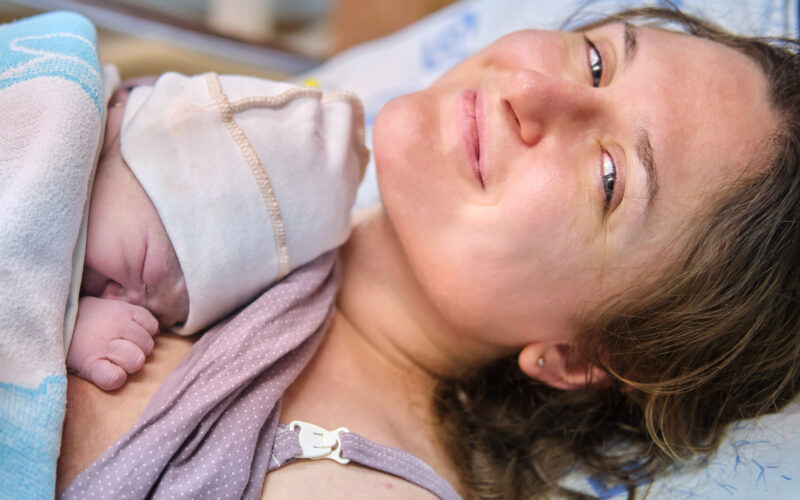In September 2020, I took up walking the neighborhood like it was a job. I did laps past our neighbors at all hours, pushing a stroller, walking the dog, listening to a podcast. Even wearing a mask when I had to because it was wildfire season in California, I was still determined to get those miles in! Then I’d return home to bounce on a yoga ball while eating dates and drinking red raspberry leaf tea.
I was desperate to go into labor with my second baby as soon as possible because I had a deadline. My OB had talked me into scheduling a repeat Cesarean section at 40 weeks and 4 days. Only about 50% of pregnancies go that far, a stressful statistic in a time when I needed to be relaxed if I wanted my first vaginal labor and delivery experience to go smoothly! I really wanted that vaginal birth after Cesarean (VBAC).
My first birth was via Cesarean section, but I hoped for something different for my second birth
My first baby had been breech. After an unsuccessful external version attempt at 36 weeks, I scheduled a C section on her due date. At 11:00 on my eldest’s birthday, I walked into an operating room on my own feet in my own mismatched socks. 51 minutes later, she was born. I never went into labor.
Fast forward two years and I was pacing the streets of our neighborhood with a mask on, binging episodes of birth podcasts, and trying to prepare myself for a “natural birth.” If I could go back in time, I would probably decline scheduling that repeat C-section in the first place, because the looming threat caused me nothing but anxiety. Fortunately, with only 36 hours to spare until the “deadline,” at 40 weeks and 2 days, I did go into labor and had the unmedicated vaginal birth I’d hoped for.
Terms to know: VBAC and TOLAC
Are you like me? Pregnant again with a history of C-section, and hoping to see things go differently this time? Let’s discuss VBACs: Vaginal Birth After Cesarean.
First, you’ll probably hear the term “TOLAC” and get offended. It stands for “Trial of Labor After Cesarean.” Like some other obstetric terms (looking at you, “Advanced Maternal Age”) this can feel super judgmental. “Oh, you’re going to let me try to labor? How generous of you.” But, remember that both your and your baby’s safety are paramount in your doctor’s eyes. And, sometimes, this may manifest as an overabundance of caution. The good news is, the old default of repeat C-sections is no longer in place. You have both options and the agency to choose the care you receive.
VBAC pros
Now, someone might wonder, why not just have another Cesarean? There are actually some great benefits to a VBAC. With a vaginal birth, you’ll have a shorter and easier recovery than you would with a Cesarean, which makes it easier to welcome a baby home with older siblings. Plus, you avoid a major abdominal surgery, with its associated risks of hemorrhage, blood clots, and infection. And since TOLAC becomes riskier with a history of multiple cesareans, a successful VBAC will improve your outlook for any future pregnancies and deliveries you may hope to have.
VBAC risks
The biggest risk of TOLAC is uterine rupture, which occurs in about 1/300 VBACs (and more frequently the more C-sections you’ve had). While it’s a very rare complication, it is quite serious, requiring an emergency Cesarean to avoid infant death or brain damage, or maternal death, hemorrhage, or hysterectomy.
Less dangerously (but still a risk to consider), a failed TOLAC (requiring an urgent repeat Cesarean) is more likely to have worse complications and outcomes than a scheduled Cesarean would have, including greater chance of hemorrhage and infection.
In short, a scheduled repeat Cesarean carries more risks, but a failed TOLAC has the potential for worse risks. That’s why it’s so important to balance those risks against the benefits of a vaginal birth, taking into consideration your own personal health history, with your doctor’s help.
The history of VBACs in America
The rates of Cesarean births and VBACs have historically fluctuated. In 1970, only 5% of all births were Cesareans, but that number increased to 22.8% by 1989 [1]. At first, a “once Cesarean, always Cesarean” policy kept the rates of VBAC very low, until the benefits of VBAC became more widely acknowledged. Between 1985 and 1996, the VBAC rate increased from 5% to a high of 28.3%, before an associated increase in uterine rupture and concerns about professional liabilities caused a dramatic reduction down to 8.5% by 2006 [1].
Research has improved, and with publications by the NIH in 2010, and ACOG in 2010 and 2017, safer and more conservative standards have achieved a relatively steady trend where, for the past decade, primary Cesareans have accounted for approximately 32% of births, and VBACs for approximately 14% of births with a C-section history.
Do women actually want VBACs?
According to a 2014 survey, approximately 48% of pregnant women with a Cesarean history wanted a VBAC, but 46% of those were denied the option to try.
Compare this to a 2014 survey statistic that approximately 48% of pregnant women with a Cesarean history wanted a VBAC, but 46% of those were denied the option to try [2]. That means that if VBAC is important to you, you might have to arm yourself with information and be willing to fight for the opportunity.
Of course, that also means that 52% of women would prefer to schedule a repeat C-section for a variety of reasons. There’s no “should” when deciding whether to plan for a TOLAC/VBAC, and the preference of the mother is just as important a factor as the medical odds and indications you discuss at your doctor’s appointments. Which means that at the end of the day, you have a personal decision to make…
Should you try for a VBAC?
If you’re reading this article and expecting again after a previous C-section, undoubtedly you’re wondering what all this information means for you, and whether you should schedule a repeat C-section, or plan for a TOLAC. First, consider why VBAC or C-section are important to you. Are you hoping to heal from a past traumatic birth experience? My advice during this decision-making process is to not put too much emphasis on this one element of your birth plan, and be sure to consider counseling in your preparations.
What are your odds for a successful VBAC?
Second, consider the factors that go into determining your personal potential for a successful VBAC. The good news is that the odds are likely in your favor, as 60-80% of VBAC attempts are successful [2]. Studies suggest no increased risk for VBAC even with twins compared to one baby [2]. Obesity, as determined by a BMI over 30, does lower a woman’s chance of a successful VBAC, but even so, success rates are still around 60%. What’s more, women with obesity are more likely to experience C-section complications than women of normal weight, indicating that VBAC may be especially helpful for these women [2].
There’s actually a resource that will give you a numerical estimate of your VBAC success. The Maternal-Fetal Medicine Units Network provides a calculator on their website. This incorporates various data to suggest how likely women like you are to have a successful vaginal delivery. It’s important to know that “no prediction model for VBAC has been shown to result in improved patient outcomes” [2]. Still, the calculator may be useful for you if, like me, you love to be prepared and want to arm yourself with information to discuss with your doctor.
What’s most important is not the percentage the calculator spits out, but the sense you can get of all the factors in your favor for a successful VBAC. For example, I had my second baby at 31 years old. I had had my cesarean because my first baby was breech, so as long as my second baby was head down, I was a good candidate for TOLAC. However, because I had never had a vaginal delivery, MFMU’s calculator gave me a 78% chance of success. By my fourth baby, I was 35 years old, but with two successful VBACs under my belt, the calculator upped my odds to 95%. So consider your health history and talk to your doctor. They should be following ACOG’s most recent guidance, which is more supportive of TOLAC than ever.
The type of C-section incision you had matters
Unfortunately, you are probably not a candidate for TOLAC if you’ve had a high vertical, or “classical” incision. Surprisingly, you cannot tell from the outside what kind of incision you had on your uterus, so you’ll want to confirm with your medical records to make sure you’re in the clear. High vertical incisions are most often used for very early deliveries (think 24 weeks gestation). Low vertical incisions, while carrying a slightly elevated risk for uterine rupture versus low transverse incisions, are still eligible for TOLAC according to ACOG’s guidelines.
Some other things that might concern your doctor, but are not blanket preclusions to TOLAC/VBAC per the ACOG guidelines, include: being past your due date, baby measuring large on scans, or a history of multiple Cesareans. These are all worth discussing with your doctor, but should not, by themselves, prohibit you from attempting a TOLAC.
Some other things that might concern your doctor, but are not blanket preclusions to TOLAC/VBAC per the ACOG guidelines, include: being past your due date, baby measuring large on scans, or a history of multiple Cesareans. These are all worth discussing with your doctor, but should not, by themselves, prohibit you from attempting a TOLAC. The 2017 ACOG guidelines are the most supportive so far of VBAC, so if your doctor has less confidence than you do, you may want to seek a second opinion. Some hospitals and doctors are more comfortable with VBACs than others, so pick a supportive (not just tolerant) doctor or midwife if VBAC is something important to you.
Where can you VBAC, and who can help you VBAC?
Depending on the reason you had a C-section(s) previously, homebirth may be out of the question for you. VBAC Link has a thorough, thoughtful article on just this topic. Perhaps the two most important points from it are: 1)” having a prior Cesarean delivery does not put you in the high-risk category” and 2) “there are no current, conclusive VBAC homebirth studies to date….There is no peer-reviewed, scientific data to show whether HBAC [home birth after Cesarean] carries more risk than home birth for those without a prior Cesarean.”
Some birth centers accept VBAC patients if you’re not a candidate for homebirth, or if you aren’t interested in homebirth, but still desire a less medicalized delivery. A 2018 study found that midwifery care can significantly increase your success rate for a successful VBAC as well, so if homebirth or a birth center are not in the cards for you, consider finding a hospital with a midwifery presence [3]. If you do give birth at a birth center, be sure the staff there have a transfer agreement with a hospital with in-house anesthesia just in case you need to be transferred for an emergency C-section. Having anesthesia staff already at the hospital when you arrive is imperative because in a true emergency every second counts.
A 2018 study found that midwifery care can significantly increase your success rate for a successful VBAC as well, so if homebirth or a birth center are not in the cards for you, consider finding a hospital with a midwifery presence.
Regardless of where you birth, consider hiring a doula. According to VBAC Link, there isn’t yet research on the effects of doula aid specific to VBAC situations. Still, what we do know suggests that doula assistance decreases your chances of having a C-section, increases your chances of having a vaginal birth, decreases the time in labor, and increases your baby’s APGAR scores at birth—all of which may be especially important for VBAC moms.
So, you’ve decided on a VBAC: Here’s what to expect
As your delivery approaches, your doctor might want to schedule a repeat cesarean “just in case” like mine did. Remember though, you have the right to consent to or decline any medical procedure done on you. I was not offered the option of induction for my first VBAC, but I was induced for my second and third VBACs, so your experience may vary as well. Induction options are limited, however, as misoprostol is contraindicated for TOLAC because it increases your risk of uterine rupture [2]. (I was given Pitocin for my inductions). Know, however, that TOLAC/VBAC does not limit your option to receive an epidural [2]. (I received epidurals for my inductions.)
If you’re giving birth in a hospital and potentially in a birth center, you’ll likely be required to have continuous electronic fetal monitoring (EFM). Baby’s heart rate is one of the few things that could indicate anything is wrong in the case of uterine rupture, where every minute counts to save baby’s life. Fortunately, many facilities have mobile EFM, where you can attach the monitoring box to an IV pole and walk the halls with it. Some facilities may also have wireless EFM.
Remember that, even if you opt to plan for a repeat C-section, you could very well go into labor on your own before the scheduled date, and if you’re already progressing, it might be recommended to trial labor anyway. Remember that just as your primary C-section probably wasn’t your first plan, babies have a way of coming on their own schedule.
The bottom line
Choosing a VBAC or a repeat C-section is a personal decision, and there’s no right or wrong answer for any woman or any pregnancy. Listen to your gut, and, along with your doctor, do your research so you have an understanding of your own individual risk. I hope that as you approach your next birth, you’re able to achieve the peace and healing you need, whatever route your birth ends up taking.
Additional Reading:
Why is delayed cord clamping so important?
References:
[1] Practice Bulletin No. 184: Vaginal Birth After Cesarean Delivery. Obstetrics & Gynecology 130(5):p e217-e233, November 2017. | DOI: 10.1097/AOG.0000000000002398 [2] Declercq ER, Sakala C, Corry MP, Applebaum S, Herrlich A. Major Survey Findings of Listening to Mothers(SM) III: Pregnancy and Birth: Report of the Third National U.S. Survey of Women’s Childbearing Experiences. J Perinat Educ. 2014 Winter;23(1):9-16. doi: 10.1891/1058-1243.23.1.9. PMID: 24453463; PMCID: PMC3894594. [3] Vedam S, Stoll K, MacDorman M, Declercq E, Cramer R, Cheyney M, Fisher T, Butt E, Yang YT, Powell Kennedy H. Mapping integration of midwives across the United States: Impact on access, equity, and outcomes. PLoS One. 2018 Feb 21;13(2):e0192523. doi: 10.1371/journal.pone.0192523. PMID: 29466389; PMCID: PMC5821332.







My daughter-in-law’s first birth was a cesarean section. She was told that she was a good candidate for VBAC and planned for it. She went to the hospital in active labor and had an epidural. Her labor slowed down and the midwives and doctor recommended doing the c-section–they said they couldn’t use pitocin to stimulate her labor. But she did have a healthy vaginal birth. I wrote about it: https://carolvanderwoude.com/2024/08/beating-the-statistics-praise-god/